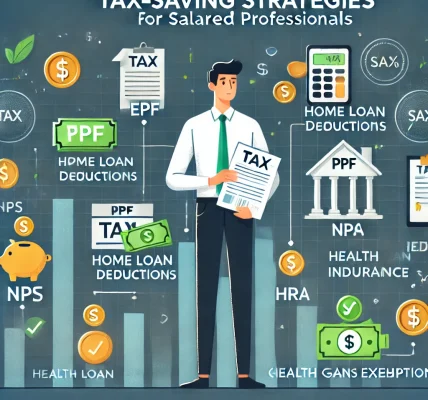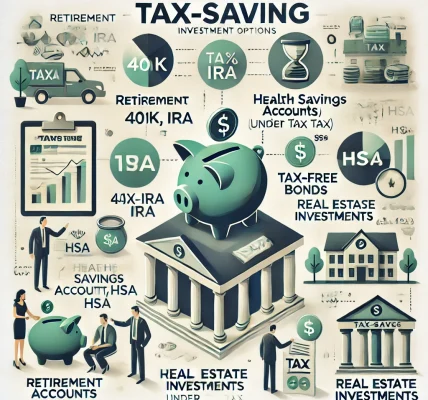In today’s world of financial planning, saving for retirement is a top priority for many individuals. While there are various options available for building your retirement corpus, one such instrument that offers excellent tax benefits and security is the Voluntary Provident Fund (VPF).
In this blog, we’ll take a deep dive into what VPF is, its tax benefits, and how it can be a smart investment choice for securing your future while saving on taxes.
1. What is Voluntary Provident Fund (VPF)?
The Voluntary Provident Fund (VPF) is an extension of the Employee Provident Fund (EPF). While the EPF is mandatory for salaried employees, the VPF allows employees to contribute more than the statutory 12% of their basic salary. The VPF is a voluntary contribution made by the employee over and above the mandatory EPF contribution.
The contributions made to VPF are eligible for tax benefits under Section 80C of the Income Tax Act, making it an attractive option for salaried individuals looking to increase their savings while also reducing their taxable income.
2. Tax Benefits of Voluntary Provident Fund (VPF)
One of the key reasons people opt for VPF is its tax benefits, which can significantly reduce your tax liability. Let’s explore the major tax advantages of VPF:
a) Tax Deduction Under Section 80C:
Contributions made to the VPF are eligible for tax deductions under Section 80C of the Income Tax Act. Just like the Employee Provident Fund (EPF), the contributions to VPF are included in the total limit of ₹1.5 lakh that can be claimed as a deduction under Section 80C.
- How it saves taxes: If you contribute a significant portion of your salary towards VPF, you can reduce your taxable income by the amount of your contribution, thereby lowering your overall tax liability.
b) Tax-Free Interest on VPF Contributions:
One of the most attractive features of the VPF is that the interest earned on the contributions is tax-free. The rate of interest on VPF is the same as that of the EPF, which is determined by the Employees’ Provident Fund Organisation (EPFO) and is generally revised every year.
- How it saves taxes: The interest earned on VPF contributions is exempt from tax under Section 10(11) of the Income Tax Act, provided the employee fulfills the continuous service requirement for five years.
c) Tax-Free Corpus Upon Withdrawal:
When you withdraw the accumulated corpus from your VPF account, it is exempt from tax under Section 10(12) of the Income Tax Act, as long as the withdrawal occurs after five years of continuous service. If you choose to keep the money in the VPF for a longer period, your corpus grows without being subjected to taxation.
- How it saves taxes: After five years of service, the amount withdrawn from the VPF account, which includes your contributions, the interest earned, and the employer’s contributions (if any), will be completely tax-free.
d) No TDS on VPF:
Unlike certain other savings instruments, there is no Tax Deducted at Source (TDS) on the amount contributed to VPF. This means you don’t have to worry about any immediate tax deductions from your contribution, allowing you to maximize your savings.
- How it saves taxes: The absence of TDS means your entire contribution is invested, allowing your savings to grow without any immediate tax deductions, maximizing the compounding effect.
3. VPF vs EPF: How Are They Different?
Both the Employee Provident Fund (EPF) and Voluntary Provident Fund (VPF) offer tax benefits, but there are some key differences between the two:
| Feature | EPF | VPF |
|---|---|---|
| Contribution | Fixed at 12% of basic salary | Flexible, above the mandatory 12% |
| Tax Deduction | Available under Section 80C | Available under Section 80C |
| Interest Rate | Determined by EPFO (revised annually) | Same as EPF, determined by EPFO |
| Tax on Withdrawal | Tax-free after 5 years of service | Tax-free after 5 years of service |
| TDS on Contribution | No TDS | No TDS |
While the EPF is mandatory, the VPF allows you to contribute more, making it a great way to increase your retirement savings and reduce your tax burden further.
4. How VPF Can Be Part of a Smart Financial Plan
When considering your overall financial plan, VPF can be an excellent way to supplement your savings for retirement. Since the VPF offers the same interest rate as EPF and comes with tax-free benefits, it is considered a safe and attractive investment option, especially for salaried employees.
a) Long-Term Investment for Retirement
Contributing to VPF ensures a secure and growing retirement corpus. The contributions grow with the benefit of compound interest, and since the VPF is a government-backed scheme, it offers a high level of security.
b) Diversification in Your Portfolio
Even though VPF provides guaranteed returns and tax benefits, it’s wise to diversify your investments across different asset classes. Consider combining VPF with other instruments such as mutual funds, stocks, and National Pension Scheme (NPS) to balance risk and returns.
c) No Risk to Principal Amount
The VPF offers guaranteed returns, unlike equity-based investments where the principal amount may be at risk. Thus, it serves as a safe, risk-free part of your portfolio, helping balance your overall risk.
5. How to Start Contributing to VPF
If you are already a part of EPF, contributing to the VPF is a simple process:
- Check with your employer: You need to inform your employer about your decision to contribute to the VPF. Most companies will have a system in place for this.
- Decide the contribution amount: You can choose how much you want to contribute, over and above the 12% of your basic salary that goes into the EPF.
- Tax Deduction: Your VPF contributions will be included in your total 80C limit of ₹1.5 lakh. Ensure you track your contributions to avoid exceeding this limit.
6. Is VPF Right for You?
The Voluntary Provident Fund (VPF) is an excellent tax-saving instrument, especially for individuals in salaried employment. If you’re looking for a safe, tax-efficient way to save for retirement and reduce your tax burden, VPF is a smart choice. However, ensure that you balance VPF with other investment options for growth, such as equity investments and NPS, to build a diversified portfolio.
Conclusion
The Voluntary Provident Fund (VPF) is a powerful tool for employees looking to save for retirement while reaping the tax benefits available under the Income Tax Act. With tax deductions on contributions, tax-free interest and withdrawals, and no TDS, VPF stands out as an efficient and secure investment choice. By contributing more than the statutory EPF, you can enhance your savings and reduce your taxable income in a simple, hassle-free manner.




